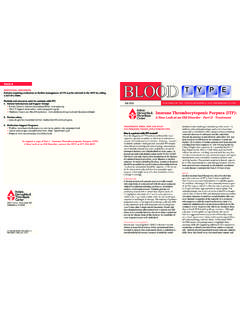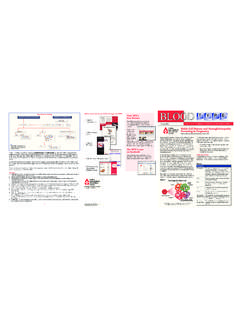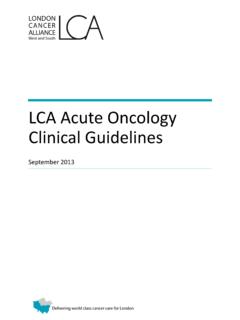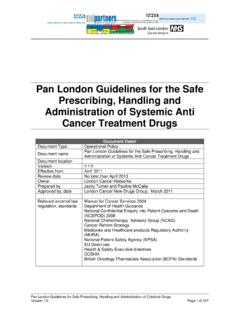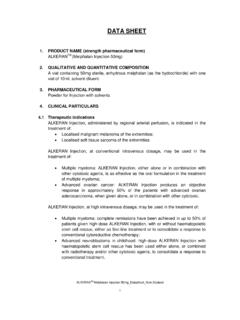Transcription of Immune Thrombocytopenic Purpura (ITP) - IHTC
1 Immune Thrombocytopenic Purpura (ITP):A New Look at an Old DisorderSpring 2010 Figure 3: General algorithm used for the evaluation of a pediatric patient with thrombocytopenia Complications of ITPThe most worrisome complication of ITP is bleeding. Typically, the risk for spontaneous bleeding is increased when the platelet count is below20,000 cells/mm3and usually below 10,000 cells/mm3, or when medications that interfere with platelet function are also utilized by the bleeding can occur in any location, with intracranial hemorrhage as the most disastrous. The age-adjusted risk of fatal hemorrhage(including intracerebral, gastrointestinal, etc.) at platelet counts persistently <30,000 cells/mm3was estimated to be , and 13% per patient/year for those younger than 40, 40-60 and older than 60 years of age, respectively. However, it should be noted that the overall incidence of major bleeding, or death from bleeding, is reported as less than one percent over a frequently observed complications result not from the ITP but from the therapies utilized for treatment.
2 Long-term steroid use mayresult in problems including hypertension, diabetes mellitus, osteoporosis, insomnia, weight gain, infections, and delirium, especially in the elderly. When steroids are utilized for therapy, the shortest efficacious course should be employed to decrease the risk of complications. As withall medications, the goal of treatment should always be weighed against potential treatment related is the prognosis for a patient with ITP?Complete responses are generally defined as sustained platelet counts over 100,000 cells/mm3. In pediatric patients, one third resolve by sixweeks after diagnosis, another third in six months and a further third become chronic. Patients diagnosed in infancy or in their adolescent yearsare at higher risk to develop a chronic course. One third of adult patients remain in remission 5 years from initial diagnosis, while two thirdsrequire re-treatment prior to 5 there inheritable forms of ITP?ITP is thought to be a sporadic disorder, with an antecedent infectious illness as the typical trigger in childhood.
3 The diagnosis of ITP in siblingsexposed to similar environmental triggers has been reported. An investigation is underway to identify candidate genes in ITP involved inhumoral immunity and its regulation. Careful history taking and recognition of bleeding symptoms in family members are important to cull out cases of thrombocytopenia that may not be due to are the future directions in the management of ITP?Overall, advancements in the understanding of the underlying Immune mechanisms causing ITP are being made. Novel therapies are first practice guidelines for the management of ITP were issued in 1996. Revised guidelines are under way and are expected to be publishedin the journal Blood in the near future. Areas that require focus in the future include the development of sensitive and specific laboratory testingto support the diagnosis, validated bleeding scores and health relatedquality of life assessments for patients affected with chronic disease. Please see the next issue of Blood Type (Fall 2010) for the final section on ITP regarding treatment.
4 ADDITIONAL RESOURCES: Patients requiring evaluation or further management of ITPmay be referred to the IHTC by calling web resources exist for patients with ITP:1. Patient Information and Support Groups Platelet Disorder Support Association PDSA: The ITP Support Association: Children's Cancer and Blood Foundation: Vaccine safety #thrombocytopenia3. Medication Support Programs Nplate: Pomacta: : 1. Blanchette M, Freedman J. The History of Idiopathic Thrombocy-topenic Purpura (ITP). Transfusion Science 1998;19 Kuhne T, Buchanan G, Zimmerman S, Michaels L, Kohan R, Berchtold W, et al. A prospective comparative study of 2540 infantsand children with newly diagnosed idiopathic Thrombocytopenic Purpura (ITP) from the intercontinental childhood ITP study Journal of Pediatrics 2005;146 Provan D, Stasi R, Newland AC, Blanchette VS, Bolton-Maggs P,Bussel JB, et al. International consensus report on the investigationand management of primary Immune thrombocytopenia.
5 Blood2009;115 Wilson D. Acquired platelet defects. In: Nathan D, Orkin S, Look A,Ginsburg D, eds. Nathan and Oski's Hematology of Infancy andChildhood. 6 ed. Philadelphia: WB Saunders; 2003 Rodeghiero F, Stasi R, Gernsheimer T, Michel M, Provan D, ArnoldD, et al. Standardization of terminology, definitions and outcome criteria in Immune Thrombocytopenic Purpura of adults and children:report from an international working group. Blood 2009;113 : NAITN eonatal alloimmune thrombocytopenia is caused by the destructionof fetal platelets by maternal IgG antibodies elicited during pregnancyand directed against fetal specific platelet antigens inherited from thefather and different from those present in the mother. These alloanti-bodies cause thrombocytopenia. Most cases arise unexpectedly, andprompt diagnosis and treatment are essential to reduce the chances of death and disability caused by variable immunodeficiency is the most commonly encoun-tered primary immunodeficiency.
6 Common variable immunodeficien-cy (CVID) is an Immune system disorder which typically affects malesand females in the third or fourth decade of life; however, it may alsobe seen in children. It is characterized by low levels of antibodies(immunoglobulins) in the blood stream and an increased susceptibilityto Thrombocytopenia-absent radius (TAR) syndrome is a rare conditionin which thrombocytopenia is associated with absence of the radiusbone in the forearms. Other common abnormalities are often presentincluding additional skeletal defects such as absence or underdevelop-ment of the other bones of the forearm (ulnae), structural malforma-tions of the heart (congenital heart defects), kidney (renal) defects. TAR syndrome is believed to be inherited as an autosomal recessivetrait. However, evidence suggests that inheritance in TAR syndromemay be more complex than simple recessive inheritance in some 's Syndrome Is an autoimmune disorder in which the body produces antibodies that destroy red blood cells, white blood cells and platelets.
7 Patients are diagnosed with thrombocytopenia and Coombs' positive hemolyticanemia and have no other known underlying etiology. The patientsmay be affected by low levels of all three types of blood cells at onetime, or may only have problems with one or two of them. The specificcause for Evans syndrome is unknown and it has been speculated thatfor every case, the cause may be different. There have been no geneticlinks identified. PAGE 58402 Harcourt Road, Suite 500 Indianapolis, IN 46260 PAGE 6 INTRODUCTION:What is ITP?ITP, Immune Thrombocytopenic Purpura , is an acquired bleedingdisorder in which the Immune system destroys platelets, blood cellsthat play a pivotal role in primary hemostasis. Individuals with ITPdevelop thrombocytopenia with a platelet count below the normalrange generally defined as less than 150,000 commonly manifests as a bleeding tendency,including Purpura (easy bruising), and petechiae (extravasation ofblood from capillaries into skin and mucous membranes).
8 HISTORY1: Identifiable descriptions of ITP date back to the 10th century whenthe Arabic physician Abu Ali al-Husain ibn Abdallah ibn Sina (IbnSina or Latin name Avicenna) described chronic Purpura . In 1658,Lazarus de la Riverius, physician to the King of France, proposedthat Purpura was due to "over thinness of the blood". Dr. RobertWillan in his book "On Cutaneous Diseases" defined four types ofpurpura in 1802. In 1883, Dr. Giulio Bizzozero of Turin, also calledthe father of the platelet, described the structure and function ofplatelets, and asserted their role in coagulation and first splenectomy in a patient with Thrombocytopenic purpurawas performed in 1916; this procedure was successful in resolvingthe thrombocytopenia and as such, subsequently, became thefavored treatment of the time. In 1923, it was noted that acute andchronic Thrombocytopenic Purpura differed only in their modern diagnostic criteria for ITP were accurately described in1940. The Harrington-Hollingsworth experiment reported in 1951,demonstrated that patients with ITP had a plasma factor that couldinduce thrombocytopenia when transfused into another unaffectedindividual.
9 This redefined the understanding of ITP to include an" Immune " component circulating in the blood of individuals affect-ed with ITP. More detailed clinical distinctions between acute andchronic ITP were also described that work suggests different autoantibody involvement in acuteversus chronic ITP and drug-associated Immune thrombocytope-nias. More recent therapeutic modalities include the use of intra-venous immunoglobulin and anti-D therapy. Further advancementsin therapy includes the use of agents licensed within the last 1 years such as eltrombopag. Contemporary studies focus on develop-ment of a detailed understanding of the autoimmune basis of ITPand exploring the underlying Immune : Overview What is the pathophysiology of ITP?The underlying pathologic process resulting in ITP is the generationof autoantibodies that react with platelet surface antigens. Oncebound to the platelets, these autoantibodies cause platelets to beremoved from circulation through phagocytosis via the reticuloen-dothelial system, primarily the spleen.
10 The resulting shortenedplatelet life span leads to thrombocytopenia; the level of thrombocy-topenia observed is based upon each affected individual's balancebetween the quantity of antibody produced, the rate of plateletremoval, and the bone marrow's compensatory ability to produceplatelets from mechanisms:The most common mechanism involved in ITP is development ofantiplatelet antibodies through the activation of antibodies are most frequently directed against platelet glyco-proteins, such as glycoprotein IIb/IIIa (the fibrinogen receptor).Some antibodies can affect the earlier lineage megakaryocytes andimpair their production of platelets in the bone marrow. Presentserological evaluations reveal detection of antibodies in only 50% ofpatients and are therefore limited as a laboratory confirmation forthis entity. It is now becoming recognized that cytotoxic T-lympho-cytes are also involved in the pathophysiology of ITP. Therefore, ITPpathogenesis involves a complex network of systemic events includ-ing interaction between B- and T-lymphocytes and inflammatorycytokines.
